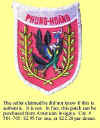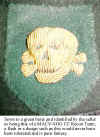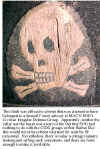|
insigne.org |
Reproductions
& Fakes
Vietnam War Insignia by Les Hughes
|
|
|
Few areas of collecting are as polluted by reproductions and fakes as that of theater-made patches of the war in Vietnam. Today the problem of copies and fakes of these insignia has reached the point where the best advice that one can give to the novice collector is to avoid Vietnamese-made insignia altogether. If you collect or have considered collecting these insignia, your time spent reading this article will be well invested. (Serious collectors of insignia from this period should be aware of Gilbert Burkett's compilation of fake insignia described in the Useful References section.) If the amount of text looks daunting, at least, view the examples. As interest in the insignia of units (both US and ARVN) that served in Vietnam grew, so did the incentive to make and sell reproductions and fakes to collectors. The situation was further complicated, from the collector’s perspective, by the fact that some of the Vietnamese involved in making original patches relocated to the United States, where they are available to make copies, and the services of those who remained in Vietnam became available as travel to Vietnam by Americans increased in the years following the end of hostilities. Today, there are dealers who travel regularly to Vietnam, or who have contacts there with whom they can deal by mail, for the purpose of securing locally-made reproductions of wartime insignia. Purchased there in quantity, the reproductions are often misrepresented as authentic by those who bring them into this country, or they are sold as reproductions to others, some of whom represent them as authentic and hike the prices. On virtually any given day, one will find example after example of these reproductions - often affixed to exotic berets - out for bid on eBay, the most visible of the many venues used to sell them. (The fact that some eBay sellers appear to have an unlimited supply of 'rare' artifacts seems not to raise the suspicions of some bidders.) These reproductions are advertised as having been made in Vietnam, a claim that usually is true, but made recently and made for the collecting market. To give you an idea of the situation that exists today, the following is abstracted from a note from a collector who traveled to Vietnam on business in April of 2001, and while there he probed the local market in militaria. "I am in Saigon at the moment and have spent the day at the War Surplus market and also with a few of the dealers that I know. The Drago French Indochina fakes have made it over here. I had not seen these particular ones before, but I assume they are French-made. (Note: On this point he may be wrong. It is believed these are not French-made, rather that they have been offered for sale in France and advertised as having been made in SE Asia. These insignia are nicely made and on the back bear the Drago name and the Rue Berenger or de Romaineville address, along with the irregular hatching as per the items of the period. All the Viet para units of the time seem to be represented as are French Para and Commando, including the Foreign Legion Heavy Mortar Company (saw 3 Rue Berenger examples at US$100 each today). The local dealers are asking between US$80 and US$130 per piece. The only way that I have been able to determine that they are fakes (I am by no means an expert) is that they appear to be noticeably heavier than the originals that I have. Also they are all single piece construction. The pin is invariably attached with a flat round tin, minus the Drago stamp. Had I not been warned in advance, and had I not found so many of the same badges whereas last time I came here I found very few, I would have certainly been fooled. As for MACV SOG, Special Forces and similar items, there seem to be thousands of them, with average prices between US$3 - US$5 each, perhaps even less after bargaining. Also appearing are a lot of the silks (bevo), SVN Marines, Mike Force etc. A couple of the local dealers are quite up front about the fact that they are fakes, and they asked me if I have a shop as they sell a lot to dealers from the US. It seems that Leroy Thompson’s book, Elite Unit Insignia of the Vietnam War, An Illustrated Reference Guide for Collectors, is one of their standard references, as I saw a couple of copies floating around. (NOTE: Many sellers on eBay point out that the item they are selling appears in Thompson's book.) The local dealers have become quite savvy to the collectors' market and will vary their price depending on whether you are a tourist, collector or dealer. Unfortunately, they identified by name only one of the American dealers buying here. I was also told that this dealer had some of the current Vietnamese para wings made somewhere, perhaps in Pakistan, and that they are being sold through a contact at one of the museums in Hanoi. I will be visiting the museums when I get to Hanoi and will try to chase this up A friend of mine, with whom I am traveling, has just looked up some of one dealer's material on eBay. One of the berets he is offering (original war time issue ARVN green beret with airborne badge), with an opening bid of $40, sells for between US$8 and US$12 at the local markets. The dealers that have them here are quite open about the fact that they are copies, so the US seller can not plead ignorance! I just arrived in Hanoi. Had a dealer come over to the hotel last night to show me some more stuff. Interesting conversation, as he was extremely knowledgeable about dealers, fakes etc. He has the Sutherland book, is aware of the use of black UV light for determining cotton ages etc., a very switched on Hombre! Also mentioned that there have been some MACV SOG silk scarves made up for a guy called *** or somebody or other. Apparently, nobody is supposed to know this (not even the guy who told me) as they have been made exclusively for the individual concerned. Also suggested that the Addressed Drago badges have been made up in Thailand. I have his email and he has promised to send my the name of the individual concerned. Incidentally, I found another four of the CERA fakes, along with all the Viet Para Battalions." Often, it is pointed out that the insigne in question appear in popular references on insignia of the war in SE Asia, such as that of Leroy Thompson (see above) or Ian Sutherland's Special Forces Of The United States Army, 1952-1982, which fact is meant to lend an air of authenticity to the insigne, when in fact the insigne was, in all likelihood, made using these books as a guides or it does not appear at all in the book, and the seller is banking (literally) on prospective bidders not having the book. (In fact, run this experiment: go to eBay and search on "Ian Sutherland" - in quotes as written - including both titles and descriptions in the search, and look carefully at the items that the search returns.) It is worth emphasizing that the problem of fakes in this area of collecting is not a recent one. Back in the mid-‘80s, several collectors I know, fearing that the influx of copies they were seeing would destroy the market for authentic, wartime Vietnamese-made insignia, sold all of their Vietnam-era insignia and never again collected them. Even if one acquires directly from veterans or from dealers or collectors of proven expertise and honesty, the profusion of copies will devalue authentic examples unless - and possibly even if - they are solidly documented. Examples of reproductions that have surfaced lately - some repeatedly - are illustrated in the images to the left and a few specific examples are discussed in what follows. The image at the left is of what the seller described as an "incountry [sic] hand embroidered gold bullion flash with smiling deaths head flasher" sewn to a "Special Forces MACV-SOG CC Recon Company green beret…" But wait, there’s more! Sewn to the liner is an "incountry hand embroidered CCC Recon Company pocket patch." The seller points the prospective buyer to Ian Sutherland’s book for confirmation, presumably, of the CCC Recon patch, as you will find no death's head flashes in Sutherland's book. This same seller offered a beret with the flash illustrated on the right. Again, a death's head flash on what appears to be a well-worn beret with an exotic patch inside, and, again, reference to Sutherland's book. (When he compiled his book, Colonel Sutherland did not imagine that individuals would use it to manufacture and flog reproductions on an unsuspecting public. This I know because a friend who knows Colonel Sutherland, having provided numerous insignia for Sutherland's book, contacted Colonel Sutherland and brought his attention to how his book is being used. Sutherland's book, by the way, is out-of-print and very difficult to find, and I doubt that many who buy the fakes under discussion have access to it, which works to the seller's favor.) These concoctions, beret/insignia combinations, are laughable in the opinion of individuals who are experts in this area. (The claim of these items having been made "incountry" may well be true, but made when? The wise money says they were made closer to 1998 than to 1968.) The reality - which rarely intrudes on these matters - is that the Special Forces are highly-trained professionals: they are not the Army’s version of the Hell’s Angels or the SS. Flashes such as these, with a death’s head, would not have been tolerated, a fact that is confirmed by men who served in Special Forces units in Vietnam. (For more on this, see Postscript below.) Furthermore, for a number of reasons, bullion rarely was employed on patches in VN. (Would you wish to wear in a combat zone a patch or a beret flash as reflective as one of bullion would be?) These flashes and others like them are pure fantasy, according to individuals who served in Special Forces, and that reality is not altered by affixing them to artificially aged berets with reproduction patches sewn inside. One would think that even if prospective buyers were not knowledgeable regarding these aspects that suspicions would be aroused when a dealer seems to have a limitless supply of these exotics or when his return privileges are restrictive or non-existent. (If there is one thing I have learned in 20 years of collecting it is that reputable dealers stand behind what they sell; indeed, when a dealer sells quality items that are accurately represented, he has no problem with items being returned.) One dealer who moves many items such as those shown here claims he cannot stand behind what he sells because he sells on consignment (a claim I find ludicrous); thus he offers no return privileges - none! - and still people buy his wares! P. T. Barnum, I fear, was correct: there's a sucker born every minute. (There is a point worth noting here. eBay places great faith in its feedback system as a means of allowing buyers and sellers to warn others of problems with specific bidders and sellers. While the feedback system may work well to alert bidders and sellers to deadbeats - individuals who renege on their obligations - it fails miserably where items are misrepresented. The reason for this is simple: feedback is generally posted by bidders upon receipt of an item and reflects whether their expectations were met. It may, however, be weeks or months before they learn that what they purchased was a copy of a fake, if indeed they ever learn. Once feedback is posted, it is chiseled in stone: it may not be changed. It is for this reason that there are eBay sellers who, in my opinion, routinely sell misrepresented items whose feedback in no way reflects that fact.) At the left are reproductions of several MACSOG patches that have surfaced in the past several years. Note the profusion of loose threads on the backs of some, typical of a number of fakes to have come to this country, many via the UK, though probably made elsewhere. Postscript Apparently one eBay seller of artifacts of the war in Vietnam noted the above comments regarding the use of the skull symbolism on Special Forces insignia, and he felt moved to respond in an ad for one of his items. He wrote (and I quote: capital letters, misspellings, incorrect word usage and all): SPECIAL FORCES SOG INCOUNTRY MADE STERLING SLIVER FRENCH COMMANDO METAL, ON REVERSE IS STAMPED VEITNAM, LONGPIG EATER, .925 (SILVER C0NTENT) & 1967. I DON'T KNOW IF THIS WAS FROM A SF TROOPERS, BUT IT SURE LOOKS LIKE SOMETHING ONE OF THEM WOULD HAVE WORN. YOU KNOW WHOW THOSE SF FELLOWS LOVED TO WEAR SKULL ON THEIR BERETS AND EVERYTHING ELSE. THEIR MACV-SOG FLAG AND ALL THEIR UNIT PATCHES HAD SKULLS ON THEM. CHECK ANY REFERANCE BOOK AND SKULLS ARE EVERY WHERE, FOR JUST ONE INSTANCE, CHECK SUTHERLANDS BOOK, AS MOST SERIOUS COLLECTORS USE IT, ON PAGE 334, IS A GERMAN WWII SS METAL SKULL DEVICE ON A RECON HAT, ON PAGE367 AUTHOR'S OWN SHOULDER RANK STRAPS HAVE A GERMAN WWII PANZER DEATH HEAD METAL DEVICE OVER THE RANK STRIPS, TWICE ON PAGE 542 AND ONCE ON PAGE 543 THE AUTHOR IS SHOW WEARING A SKULL AND CROSSED BONES "BERET BADGE" ON HIS OWN BERET. NOT JUST SINGLING OUT THIS REFERANCE BOOK AS ALL VEIT REFERANCE BOOKS ARE LOADED WITH THE SAME TYPE PHOTOS OF SF TROOPERS WEARING SKULLS. THAT IS THE WAY IT WAS, CHECK WITH ANYONE WHO WAS THERE! AND I THINK OF SUTHERLAND AS A HERO!!!!! SORRY TO RAMBLE, BUT COLLECTING ANYTHING ONE HAS TO DEAL WITH SO CALLED "EXPERTS" OUTSTANDING IN THERE OWN MINDS, OR FIELDS,(CORN FIELDS MAYBE). One would think that anyone selling artifacts of the war in Vietnam would learn how to spell "Vietnam" correctly, but this individual invariably renders that word as Veitnam. (It is interesting that the commando "metal" he describes bears on its back - hand-stamped, it appears - the word "Veitnam.") "Check with anyone who was there!" he urges us. That is exactly what I have done, and none of these SF veterans of Vietnam recall the skull appearing on any beret insignia until after the war. One of these veterans, who assisted Col. Sutherland with his book, queried him regarding the matter of such insignia, and here is what Col. Sutherland wrote (I quote): "I 'commanded' a PRU unit when I was a province officer with the CIA. I designed .. more or less .. the skull and crossed bones insignia on my black beret in the photographs in the book. Special Forces at that time and in my province was not highly thought of, therefore I didn't wear the green beret to identify with them. No one wore the black beret at the time.. and no one claimed it as far as I can recall. I don't remember anyone else wearing anything like a skull and crossed bones but we normally did not see this kind of stuff outside the province ...people who wore uniforms, berets and other "military" type stuff didn't wear it to the gatherings at Region or Saigon where we would likely see it.... If you will look at the C-3 Recondo patch with the skull and crossed bones one of them is identical to the SS insignia .. it was intentional but the Vietnamese tailors seldom got it right! But, I suspect that ASMIC is right. I have never seen or heard of a SF beret insignia with a skull and crossed bones. Of course, with SF troops all over the world, I would believe that some enterprising soul has developed one somewhere .. don't remember seeing it in Vietnam or after the war at Bragg, but you know, those "beer can specials" could be made anywhere." |








